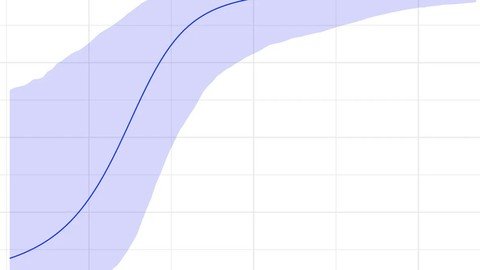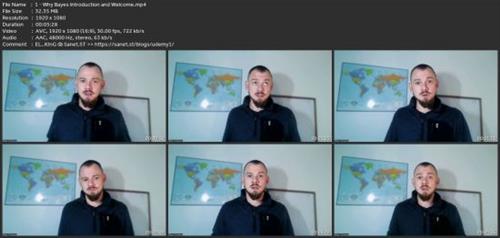- Thread Starter
- #1
Applied Bayesian Analysis With R

What you'll learn
Learn the difference between frequentist and bayesian approaches
Gain confidence with the bayesian workflow in R
Learn how to specify a variety of Bayesian models
Leverage bayesian regression for predictive modeling
Requirements
Basic familiarity with R and statistical inference
Description
This course provides a comprehensive, hands-on approach to Bayesian statistics, focusing on fundamental concepts and practical applications using R. Designed for beginners and those with some statistical background, this course will guide you through the core principles of Bayesian analysis, allowing you to understand and apply these methods to real-world data.Course StructureLecture 1: Why Bayes? Introduction and WelcomeWe start with a fundamental question: Why Bayesian statistics? This lecture introduces the advantages of Bayesian thinking, contrasting it with frequentist methods to highlight how Bayesian analysis provides a flexible, intuitive approach to data. This session sets the stage for understanding the Bayesian perspective and what you can expect to gain from this course.Lecture 2: R Setup for Bayesian StatisticsIn this session, we'll set up R for Bayesian analysis, covering essential packages and libraries, and walk through basic commands for data manipulation and visualization. By the end, you'll be equipped with the tools needed to dive into Bayesian modeling.Lecture 3: The Bayesian Trinity: Priors, Likelihood, and PosteriorsHere, we explore the three central components of Bayesian analysis: priors, likelihood, and posteriors. We'll discuss how these elements interact to shape Bayesian inference and will use R to visualize how prior beliefs combine with data to form posterior distributions.Lecture 4: Bayesian Regression in RThis lecture delves into Bayesian regression, covering linear models in a Bayesian framework. You'll learn how to specify priors, compute posterior distributions, and interpret results, building on classical regression knowledge to gain a Bayesian perspective.Lecture 5: Logistic Regression and PredictionsExpanding on regression techniques, this session introduces Bayesian logistic regression, ideal for binary outcomes and classification. You'll learn to make probabilistic predictions and understand uncertainty, essential for interpreting results in Bayesian analysis.Lecture 6: Diagnostics and VisualizationDiagnostics are critical for ensuring model reliability. This lecture covers methods for evaluating model fit, assessing convergence, and visualizing posterior distributions. We'll use R's plotting tools to gain insight into model behavior, helping you detect and address potential issues.Lecture 7: Practical Tips and ConclusionsIn our final lecture, we'll discuss practical tips for successful Bayesian analysis, including choosing priors, understanding model limitations, and interpreting results. We'll review key takeaways and best practices, equipping you with a well-rounded foundation to apply Bayesian methods confidently.This course is designed to be interactive, providing hands-on exercises to reinforce concepts and develop practical skills in Bayesian statistics using R. By the end, you'll have the tools and knowledge to apply Bayesian thinking to real-world data analysis challenges confidently. Welcome, and let's begin our Bayesian journey!
Overview
Section 1: Introduction
Lecture 1 Why Bayes? Introduction and Welcome
Lecture 2 Bayes Theorem
Lecture 3 Bayesian Priors in Detail and a Little About Sampling
Lecture 4 Bayesian Regression in R
Lecture 5 Logistic Regression and Predictions
Lecture 6 Diagnostics and Validation
Lecture 7 Practical Tips and Conclusions
Researchers and analysts seeking to learn applied statistical modeling

Say "Thank You"
rapidgator.net:
ddownload.com:

Published 11/2024
MP4 | Video: h264, 1920x1080 | Audio: AAC, 44.1 KHz
Language: English | Size: 494.88 MB | Duration: 1h 12m
An accessible introduction to Bayesian statistical modeling
MP4 | Video: h264, 1920x1080 | Audio: AAC, 44.1 KHz
Language: English | Size: 494.88 MB | Duration: 1h 12m
An accessible introduction to Bayesian statistical modeling
What you'll learn
Learn the difference between frequentist and bayesian approaches
Gain confidence with the bayesian workflow in R
Learn how to specify a variety of Bayesian models
Leverage bayesian regression for predictive modeling
Requirements
Basic familiarity with R and statistical inference
Description
This course provides a comprehensive, hands-on approach to Bayesian statistics, focusing on fundamental concepts and practical applications using R. Designed for beginners and those with some statistical background, this course will guide you through the core principles of Bayesian analysis, allowing you to understand and apply these methods to real-world data.Course StructureLecture 1: Why Bayes? Introduction and WelcomeWe start with a fundamental question: Why Bayesian statistics? This lecture introduces the advantages of Bayesian thinking, contrasting it with frequentist methods to highlight how Bayesian analysis provides a flexible, intuitive approach to data. This session sets the stage for understanding the Bayesian perspective and what you can expect to gain from this course.Lecture 2: R Setup for Bayesian StatisticsIn this session, we'll set up R for Bayesian analysis, covering essential packages and libraries, and walk through basic commands for data manipulation and visualization. By the end, you'll be equipped with the tools needed to dive into Bayesian modeling.Lecture 3: The Bayesian Trinity: Priors, Likelihood, and PosteriorsHere, we explore the three central components of Bayesian analysis: priors, likelihood, and posteriors. We'll discuss how these elements interact to shape Bayesian inference and will use R to visualize how prior beliefs combine with data to form posterior distributions.Lecture 4: Bayesian Regression in RThis lecture delves into Bayesian regression, covering linear models in a Bayesian framework. You'll learn how to specify priors, compute posterior distributions, and interpret results, building on classical regression knowledge to gain a Bayesian perspective.Lecture 5: Logistic Regression and PredictionsExpanding on regression techniques, this session introduces Bayesian logistic regression, ideal for binary outcomes and classification. You'll learn to make probabilistic predictions and understand uncertainty, essential for interpreting results in Bayesian analysis.Lecture 6: Diagnostics and VisualizationDiagnostics are critical for ensuring model reliability. This lecture covers methods for evaluating model fit, assessing convergence, and visualizing posterior distributions. We'll use R's plotting tools to gain insight into model behavior, helping you detect and address potential issues.Lecture 7: Practical Tips and ConclusionsIn our final lecture, we'll discuss practical tips for successful Bayesian analysis, including choosing priors, understanding model limitations, and interpreting results. We'll review key takeaways and best practices, equipping you with a well-rounded foundation to apply Bayesian methods confidently.This course is designed to be interactive, providing hands-on exercises to reinforce concepts and develop practical skills in Bayesian statistics using R. By the end, you'll have the tools and knowledge to apply Bayesian thinking to real-world data analysis challenges confidently. Welcome, and let's begin our Bayesian journey!
Overview
Section 1: Introduction
Lecture 1 Why Bayes? Introduction and Welcome
Lecture 2 Bayes Theorem
Lecture 3 Bayesian Priors in Detail and a Little About Sampling
Lecture 4 Bayesian Regression in R
Lecture 5 Logistic Regression and Predictions
Lecture 6 Diagnostics and Validation
Lecture 7 Practical Tips and Conclusions
Researchers and analysts seeking to learn applied statistical modeling
Screenshots

Say "Thank You"
rapidgator.net:
You must reply in thread to view hidden text.
ddownload.com:
You must reply in thread to view hidden text.
